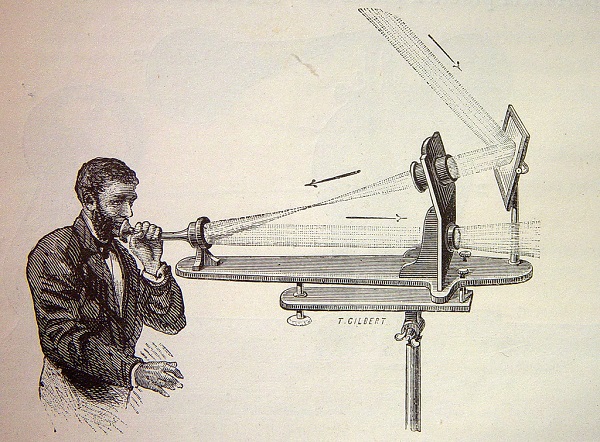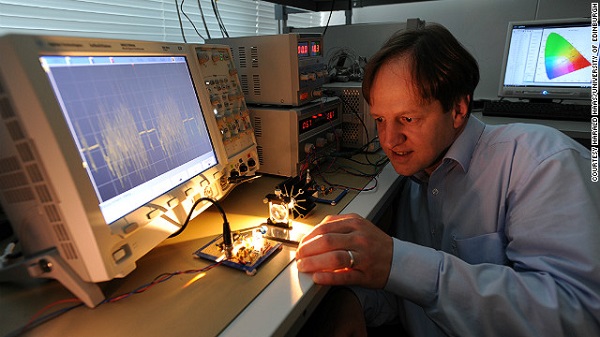
Technology has a habit of taking a long time to develop. Alexander Graham Bell may have developed the telephone (or stole it according to some sources), but his greatest achievement may have been the photophone. He certainly thought so, telling a reporter just that right before his death.
In 1880, Bell found a way to transmit signals using mirrors and sunlight. He was the first person to be able to make voice calls using light alone. However, the technology had to be abandoned due to the fact that sunlight is extremely unpredictable and there was no other way to reliably created light signals at the time.
Story continues after the break.

Fortunately, someone has picked up where Bell left off. Harald Haas of the University of Edinburgh has been working on what is known as Visible Light Communications (VLC) or Li-Fi as it is being called these days. LEDs are modified to transmit information by flickering on and off to simulate a digital binary signal. Essentially, a burst of light is a 1 and turning off is a 0. And it does this at a high enough frequency that the human eye is unable to tell that anything is happening.
And it still works even if the LED is turned down low enough to appear off.
Some may remember the Infra-Red transmitter/receivers that were built into older cellphones. This was before Wi-Fi and Bluetooth became the modern standard. Infra-Red communication was painfully slow, and transferring files took a very long time. Provided that the transmission wasn’t interrupted by something getting in the way of the signal.

Li-Fi on the other hand is able to transmit at a rate of 3Gbps, per spectrum. Haas explained in an interview with the Australian Broadcasting Corporation that he is able to broadcast the signal on many different wavelengths of light. The rate of 3Gbps would be confined to each colour, which means that he would be able to transmit Red-Green-Blue for a total of 9Gbps and the result would be ordinary white light. Nobody would even be able to tell that there are gigabits of information shooting out of their lights.
There is also the issue of bandwidth. The current range of RF transmissions is currently becoming very crowded. Broadcast stations, telcos, government and military communications all come together to use up almost all of the spectrum. With new wireless technologies also appearing, it is a matter of time before demand outstrips supply. Light on the other hand, has a much wider range of frequencies that radio. The capacity is as much as 10,000 times greater. Meaning that there is so much more space to be used.
Light is not affected by the same problems as RF, Which allows Li-Fi to be used in areas where regular WiFi would be too disruptive. Hospitals would be able to remain connected without the radio waves interfering with sensitive medical equipment; while underwater operations would be able to use it to remain in contact for deep sea operations without the use of cables. It would also allow for an internet connection in aircraft, due to the lack of transmissions that might interfere with navigation systems. Although there is a consensus that those systems are already shielded against interference.

Haas has also spoken about the energy efficiency of using LEDs to transmit signals over the highly inefficient RF towers. He points out that there are 1.4 million base stations around the world. Collectively these towers use more than 2 Gigawatts of electricity, only 5% of which goes into actually transmitting information. The rest is used for cooling.
LEDs are already more efficient than traditional incandescent lights that illuminate more of the world. Replacing street lights with Li-Fi technology will not only reduce the cost keeping cities lit, but it will also completely remove the cost of maintaining radio towers. A fact that Haas pointed out during a 2011 TedTalk.
Critics point out that visible light is unable to penetrate solid objects, thus greatly limiting the range of the technology. RF signals are able to travel through walls, although the signal itself is reduced by the composition of the objects it has to pass through. Haas is quick to debunk this criticism by explaining that the Li-Fi system will be built into the light fixtures within a building. This would allow for an uninterrupted relay of signal emitters.
More importantly, the ease of containing signals makes it harder to hijack wireless networks. Especially for secure installations that deal with sensitive information. All that needs to happen is for someone to close the windows.
The greatest challenge faced by Haas and his team is creating a two-way stream of communications. Receiving Li-Fi signals with a light fixture requires more modifications than just transmitting a signal. A fact that could drive up the cost of installing the system. Something that manufacturers may balk at, due to the difficulty in deploying the infrastructure.

We won’t be converting our modern wireless communications over to Li-Fi completely. Due to the range limitations of light, we will be sticking with RF for a long while. It is likely that Li-Fi will be confined to smaller networks inside buildings or for short range communications.
This technology is already commercial, with a small group of international companies forming a consortium to promote and deploy Li-Fi. These companies are also at the forefront of VLC research, and are mostly responsible for getting it into places where it would be the most beneficial. With many builders turning to LEDs to illuminate the world, we are on the brink of literally seeing the light.

